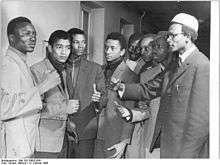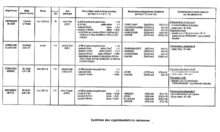Gerboise Bleue
Gerboise Bleue (French: [ʒɛʁbwaz blø], "blue jerboa") was the name of the first French nuclear test. It was an atomic bomb detonated near Reggane, in the middle of the Algerian Sahara desert on 13 February 1960, during the Algerian War (1954–62).[1] General Pierre Marie Gallois was instrumental in the endeavour, and earned the nickname of père de la bombe A ("father of the A-bomb").
Gerboise is the French word for jerboa, a desert rodent found in the Sahara. The following three bombs detonated near Reggane were named respectively "white" (Gerboise Blanche), "red" (Gerboise Rouge), and "green" (Gerboise Verte).
The most powerful first A-bomb test
On February 13, 1960 at 6:04 AM (GMT), the plutonium filled Gerboise Bleue was detonated atop a steel tower with an altitude of 100m. The command post was located 16 kilometers away from the blast. In order to study the immediate effects, military equipment was placed at varying distances from the epicenter, while jets flew overhead to take samples of radioactive particles. No journalists were allowed on site, however an eyewitness account was given to the French press, saying “the desert was lit up by a vast flash, followed 45 seconds later by an appreciable shock-wave; an “enormous ball of bluish fire with an orange-red centre” gave way to the typical “mushroom” cloud”[2]
With Gerboise Bleue, France became the fourth nuclear power, after the United States, the USSR, and the United Kingdom. Prior to this test, there had been no nuclear detonations for 15 months. Gerboise Bleue was by far the largest first test bomb up to that date, larger than the American "Trinity" (20 kt), the Soviet "RDS-1" (22 kt), or the British "Hurricane" (25 kt). The yield was 70 kilotons, bigger than these three bombs put together.
In comparison, Fat Man, the Nagasaki bomb, was 22 kilotons, one-third as powerful.
As the atomic yield of a new bomb design cannot be precisely predicted, the French army planned an explosion between 60 and 70 kt. Gerboise Bleue was a total success, yielding the full designed power.[3] However, because of the bomb’s irregularly high yield, some experts believe that the bomb may have been "overfilled with plutonium to assure success".[4]
Only two other A-bombs tested in the Sahara facilities were more powerful: "Rubis" (<100 kt, 20 October 1963), and "Saphir" (<150 kt, 25 February 1965). Both were detonated underground at the In Ekker facilities.
Subsequent tests
From February 1960 to April 1961, France tested a limited number of atmospheric bombs in Reggane facility's C.S.E.M. (Centre Saharien d'Expérimentations Militaires, or "Saharan Center for Military Experiments"): the four Gerboise bombs. Three of them were only engins de secours ("emergency devices"), with yields deliberately reduced to less than 5 kilotons.
Shortly after the final Gerboise bomb (Gerboise Verte), the French moved their nuclear testing to the mountainous In Ekker region, which housed an underground facility. In 1962, the Algerian War ended with the signing of the Evian Accords. Although the French military agreed to withdraw from Algeria within 12 months, Chapter III of the Evian Accords granted France "the use of a number of military airfields, the terrains, sites and installations necessary to her."[5] It was because of this stipulation that France was able to continue nuclear testing in Algeria until 1966. With the underground tests the sequence designation was changed to jewel names, starting in November 1961 with "Agathe" (agate; <20 kt). On 1 May 1962, during the second test, the "Beryl incident" (incident de Béryl) occurred, which was declassified many years later.
All other French atomic-bomb tests, including Canopus, were carried out in French Polynesia from 1966 to 1996. The last bomb, Xouthos (<120 kt), was detonated on 27 January 1996.
Critics and international reactions
According to Lieutenant Colonel Warner D. Farr in a report to the USAF Counterproliferation Center "Progress in nuclear science and technology in France and Israel remained closely linked throughout the early fifties." Furthermore, according to Farr, "There were several Israeli observers at the French nuclear tests and the Israelis had 'unrestricted access to French nuclear test explosion data.'"[6]
In France, the news of Gerboise Bleue’s success was generally met with satisfaction and national pride. President De Gaulle stated:
| “ | Hurray for France! Since this morning, she is stronger and prouder.[7][8] | ” |
However, the nation faced many international critics following the nuclear test, especially from the African continent. Just days after Gerboise Bleue, all French assets in Ghana were frozen, “until such time as the effects of the present explosion and the future experiments referred to by the French Prime Minister become known.”[2] Morocco, who lays claim to the portion of the Sahara where the bomb was detonated, withdrew its ambassador from Paris just two days after the event. Other African nations expressed their disappointment with France’s decision to test nuclear weapons in the Sahara, citing fears of radioactive fallout and the safety of their citizens.

Five months after the last Gerboise A-bomb, the Soviet Union responded by breaking its atmospheric tests moratorium, settled de facto since late 1958 with the United States and the United Kingdom. The USSR conducted many improvement tests, starting in September 1961 with a series of 136 large H-bombs. The series included the most powerful bomb ever tested, the 50-megaton (50,000 kt) "Tsar Bomba", which was detonated over Novaya Zemlya.
Following the USSR, the United States reactivated its own atmospheric test program with a series of 40 explosions from April 1962 to November 1962. This series included two powerful H-bombs topping 7.45 Mt and 8.3 Mt.[1]
China also launched its own nuclear program, resulting in the A-bomb "596" (22 kt) tested on 16 October 1964, and the H-bomb Test No. 6 (3.3 Mt), tested 17 June 1967.
In 1968, France detonated its first thermonuclear weapon, Canopus (2.6Mt), at the new facility at Fangataufa, a desert atoll in French Polynesia.
Programme

- 13 February 1960: Gerboise Bleue ("blue jerboa"): 70 kt
- 1 April 1960: Gerboise Blanche ("white jerboa"): <5 kt
- 27 December 1960: Gerboise Rouge ("red jerboa"): <5 kt
- 25 April 1961: Gerboise Verte ("green jerboa"): <1 kt
Gerboise Rouge was followed by a joint exercise, in which infantry, helicopters and armour reconnoitered the contaminated area.[9]
Gerboise Verte was intended to yield between 6 and 18 kilotonnes, but effectively yielded less than 1.[9] Like Gerboise Rouge, it was followed by a joint exercise in the contaminated area, codenamed Garigliano.[9] The test had been patched up hastily and fired prematurely because of the Algiers putsch, as it was feared that the nuclear bomb could fall in the hands of seditious elements.[10] As a result, the bomb yielded less than 1 kiloton, 10 times less than the intended output.
Consequences
For decades, documentation of the Gerboise tests remained heavily classified by the French government. The Ministry of Defense had maintained that the radioactive effects on humans present at the site would be “weak”, and “well below annual doses.”[11] However, persons present at the site have since stated that protection gear was extremely minimal at the time of testing. In addition, ex-militants have come forward with stories of being used as test subjects to study the effects of nuclear radiation on humans. Immediately following the explosion of Gerboise Verte (which yielded <1 kiloton), soldiers were sent within a 1 km radius of the explosion site, where they practiced combat exercises and drove tanks around the area. In total, these subjects were exposed to high levels of radiation for three hours. Following the exercises, the soldiers state that they were given showers as the only means of decontamination.[9]
In 2005, the Algerian government conducted a study to assess the radioactivity of former nuclear testing sites. The report showed there to still be high residual levels of activity at the ground zero site of Gerboise Bleue and Gerboise Blanche. However, the report also stated that these levels were not enough to warrant intervention and did not pose a threat to visitors of the area or inhabitants of Reggane.[12]
In 2009, the French government agreed to compensate victims who had been exposed to nuclear radiation as a result of the testing in Algeria and French Polynesia. The government also agreed to release additional documents which detailed how the tests had been carried out.[13]
Specifics
- Time: 6:04 13 February 1960 (GMT)
- Location: Tanezrouft (near Reggane)
- Test Height and Type: Tower, 100 m
- Yield: 70 kt
See also
- Agathe (atomic test) (French underground A-bomb)
- Canopus (French H-bomb)
- Force de Frappe
- List of states with nuclear weapons
- Nuclear weapons and France
Notes
- 1 2 French Senate report #179: The first French tests in the Sahara
- 1 2 "Nuclear Device exploded in the Sahara. - Afro-Asian Reactions. - Ghana freezes French Assets.- Moroccan Ambassador withdrawn from Paris". Keesing's Record of World Events. 6 (2): 17279. February 1960.
- 1 2 French Senate report
- ↑ Reed, Thomas; Stillman, Danny (2009). The nuclear express : a political history of the bomb and its proliferation. Zenith Press. p. 111. ISBN 978-0-7603-3502-4.
- ↑ "Algeria: France-Algeria independence agreements (Evian agreements)". International Legal Materials. 1 (2): 214–230. October 1962. JSTOR 20689578.
- ↑ Farr, Warner D (September 1999), The Third Temple's holy of holies: Israel's nuclear weapons, The Counterproliferation Papers, Future Warfare Series, 2, USAF Counterproliferation Center, Air War College, Air University, Maxwell Air Force Base, retrieved July 2, 2006
- ↑ Hourra pour la France ! Depuis ce matin, elle est plus forte et plus fière.
- ↑ Il y a cinquante ans, la France réalisait son premier essai nucléaire, Jean-Dominique Merchet, Libération, 13 February 2010
- 1 2 3 4 Essais nucléaires : Gerboise verte, la bombe et le scoop qui font plouf... (actualisé), Jean-Dominique Merchet, Libération
- ↑ Sahara: les cobayes de «Gerboise verte», Le Nouvel Observateur, Vincent Jauvert, 5 February 1998
- ↑ Merchet, Jean-Dominique (2010-02-16). "Essais nucléaires : Gerboise verte, la bombe et le scoop qui font plouf... (actualisé-3)". Libération.
- ↑ "Radiological conditions at the former French nuclear test sites in Algeria : preliminary assessment and recommendations." International Atomic Energy Agency, Vienna 2005. (Radiological assessment reports series, ISSN 1020-6566) ISBN 9201133049 https://www-pub.iaea.org/MTCD/publications/PDF/Pub1215_web_new.pdf
- ↑ Cowell, Alan (2009-03-24). "France to Pay Nuclear Test Victims". The New York Times. ISSN 0362-4331. Retrieved 2018-04-08.